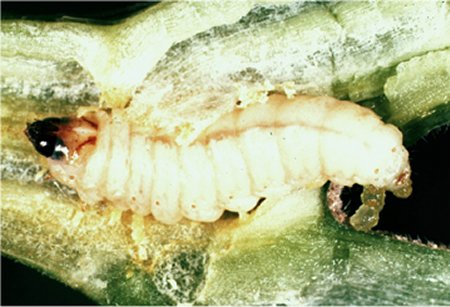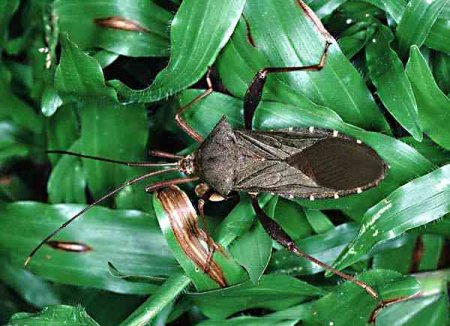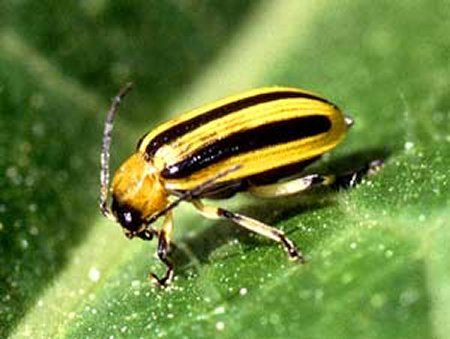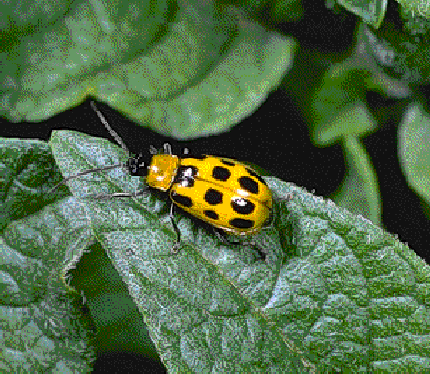
2005 Year in Review
Back to Page two: Other Listing | Back to Year in Review Index
Squash and Vine Problems |
|
Source: Maurice Ogutu (708) 352-0109; James Schuster (708) 352-0109; Contact: Bob Sampson, Extension Communications Specialist, Phone (217) 244-0225; rsampson@uiuc.edu Squashes, cucumbers, and melons face a number of disease and insect pests, two University of Illinois Extension horticulture educators warn. James Schuster and Maurice Ogutu urge home gardeners to keep an eye on their vines to head off problems. "Squashes have numerous disease and insect pests," said Ogutu. "One of the more serious insect pests is squash vine borer. This insect tunnels into the stem within six inches of the soil line. The insect feeding is severe but would not generally be fatal to the plant. However, a bacterial rot almost always follows the insect into the vine. This causes the vine to decay and turn mushy. Water and nutrients are cut off from the diseased area out to the tip. Thus, the vine wilts and dies." Squash vine borer has been sprayed so often that the insect has resistance to most insecticides. However, homeowners may still get some control if they treat the plants once a week with carbaryl until the squashes start to form. "Use according to all label directions and precautions," Ogutu said. "The first application is applied when the plant begins to vine out. Treat the plants' crown and runners. A non-chemical control is to cover the plants with polyester row covers from the day planted until the blooming starts. Make sure the edges are buried so the insects cannot get under the cover." Schuster said the squash bug is also a pest. It lays a mass of reddish eggs on the bottom side of the leaves. "Destroy these eggs before they hatch," he recommends. "Keep the garden free of debris. Lay down boards, and during the day lift the boards and destroy the bugs hiding under them. "Another control is to use pyrethrins. Use these according to all label directions and precautions." Cucumber beetles not only attack cucumbers but also squashes and melons. These insects can cause serious feeding damage. In addition, they also carry a disease called "Bacterial Wilt" that is fatal to the infected plants. "It takes about six weeks for the disease to kill the plant," said Ogutu. "If the insects infect the plants while they are seedlings, the plants will be dying or dead by fruit set." Schuster said carbaryl or rotenone can be used to control cucumber beetles. Either should be used according to all label directions and precautions. "Apply in the spring and continue until the plants begin to bloom," he said. "Once flowering starts, the insecticides can still be used but only just before sunset to avoid killing the bees necessary for pollination. Stop all sprays at least two weeks before harvesting any crop. "A non-chemical control is to use the polyester row covers. These cucumber beetles tunnel in the soil when necessary. So the edges of the row cover need to be buried fairly deeply to help reduce the chance of the insects tunneling under the cover to get to the plants. Keep the cover on until both male and female flowers are on the plant." The stem of the mail flower is straight from vine to blossom, he noted. Female flower stems have a bulge just behind the flower. "At first, only male flowers are produced," Schuster said. "When the plants start to send out side shoots, the females develop on the main stem, and the males are produced on the side shoots. At this point, the covers need to be removed so that bees can pollinate the flowers." For more information on vine crop pests, Ogutu and Schuster recommend home gardeners visit this U of I Extension website: Common Problems by Editor, theCity1.com |
|
Copyright © 2005 TheCity1.com.
All rights reserved



